Editor's note: today we have Michael from SaaSbrand sharing tips to improve your social presence in order to amplify your link building efforts.
There are no shortcuts in link building, but extending your reach and recognition is vital to promoting link-worthy content. Social media is a great platform for building a network and sharing your content.
Take it away, Michael.
Building natural high-quality backlinks is hard. You need a whole lot of resources to build backlinks.
Imagine if you could multiply your link building efforts. Better yet, what if that was possible without spending money on expensive tools?
You can use social media to multiply your link building efforts. Statistics show that social signals can have an impact on search engine rankings (although Google continues to remain firm that social signals are not part of their ranking algorithm).
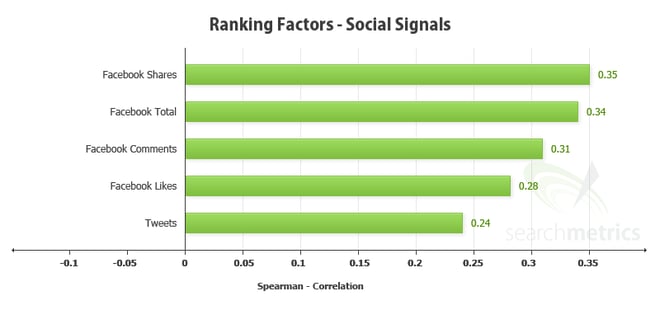
How can social signals affect SEO? AJ Kohn does a fantastic job explaining it in this post.
So how can you use social signals to boost your link building efforts?
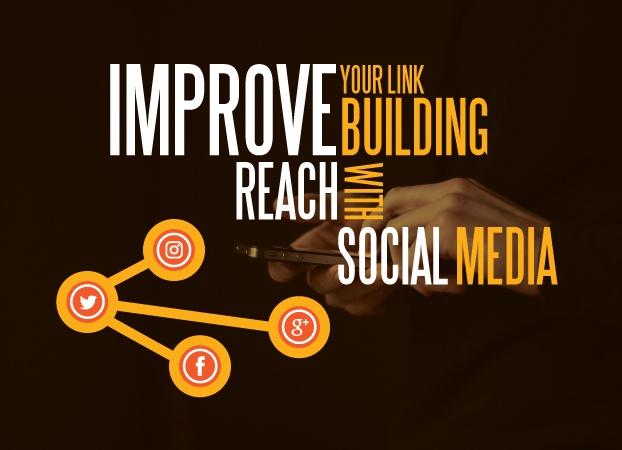
Follow the six steps outlined below.
1) Creating the Right Mindset (Value)
What is your goal? What’s your objective?
If your primary objective is to build links from social sites, you’re moving in the wrong direction.
Instead, your objective should be to acquire leads or to increase revenue. Treat social media as the platform it is, rather than using it only to manipulate SEO.
Create the right mindset and avoid using spammy tactics.
Social media is a fantastic platform to build an audience and interact with your community. Yes, social signals can influence ranking factors, but you shouldn't go out and spam Facebook with links to your landing page. This is more likely to have a negative impact. Instead, you should work to engage with your community and deliver real value to your audience.
Here’s a post detailing examples of good and bad social media posts.
What makes a social media post bad? What is a bad social media strategy?
Any social media strategy that revolves around pushing products, telling people to buy. Remember, people use social networks to socialize and engage, not shop for new products.
Your social posts must deliver value to engage your followers, create brand affinity, and build an audience.
Your social posts don't need links to impact SEO. It's the ability to amplify your message that makes social media valuable -- and can actually lead to inbound links.
If your objective is to generate leads and increase brand awareness, you don’t have to spam your social network accounts with links. You’ll earn more links by engaging with your social fans. Just give it a try.
2) Track and Monitor Trends
Use trending topics to craft irresistible content that your social fans and influencers will feel obliged to share. For example, when I searched for “landing pages” in Google Trends, here’s the trend:
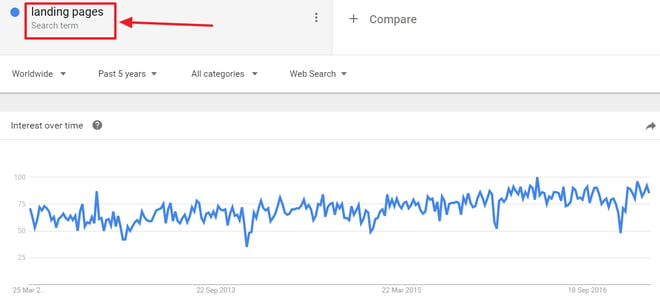
As you can see, the trend is pretty static (although with a slight increase in 2016). You could create content on this topic, but ideally, you want related searches.
So just scroll down the Google Trends results page, and you’ll find the “Related queries” section. This will show topics related to your head term, which in this case is [landing pages].
Any of these queries will guide the next content topic. Why? Because they’re rising in popularity. Take a look:
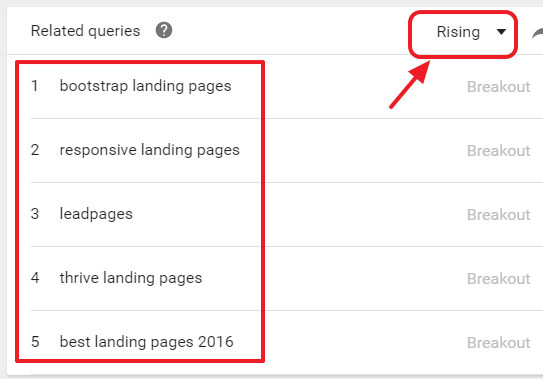
Reach out to people interested in the trend (almost everyone in your field), and they will feel excited to join the movement.
The simple steps you can take are:
- Use Google Trends to find latest trends in marketing (scroll down the page and pick any of the related queries).
- Create a blog post around the trending topic. Make it 10x better than what’s already out there.
- Use the appropriate hashtags to find people who will be interested in your post.
- Reach out to influencers and share your latest post. If you connect with 30 influencers and gain 5 links, isn’t it worthwhile? I would say so.
When iPhone 6 Plus was released, everyone was busy discussing its usability flaws and how some people ended up breaking their phones, KitKat posted this awesome tweet.
We don't bend, we #break.
— KITKAT (@KITKAT) September 24, 2014
#bendgate #iPhone6plus pic.twitter.com/uippCg4kCi
It’s funny, but because the right hashtags were used and the topic was trending at the time, the post generated nearly 26K retweets and 13K likes.
You too can use the same strategy to create brand awareness and increase the possibilities of getting more inbound links naturally.
3) Find Viral Content
Viral content usually generates the most social shares. And the potential for getting more links from viral content is high – you just have to leverage the sharers (people who shared the viral post).
When you find viral content and understand the psychology behind content virality, it means that you can also create content with the same format, style, and even target the same keyword – and get tremendous results.
Using the Skyscraper technique, you can make your own content better – then reach out to those who participated in the viral content and respectfully nudge them to share it on social networks.
Here’s how to do it.
Use Buzzsumo to find the most shared content in your industry. For example, I entered “user onboarding” into the search box and clicked on the “Go!” button at the right side, here are the results of the most shared content on that topic (not keyword):
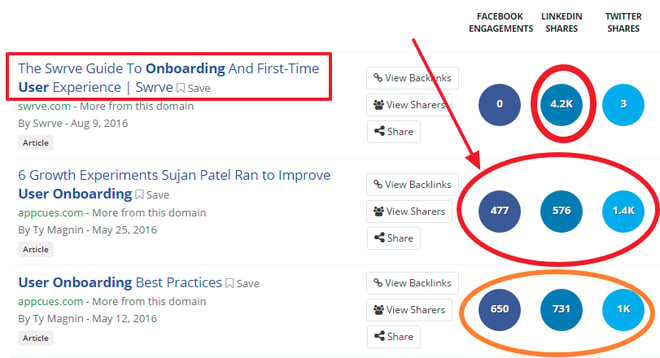
At a glance, you can see that the first content on Swrve.com generated well over 4,000 social shares on the major social media networks. The title of the post is:
The Swrve Guide to Onboarding and First-Time User Experience
You’ll notice that the power word used in the title is “Swrve,” and not “ultimate” or “definitive” as you would expect.
Adding your brand name in the title for long-form content helps effectively brand your viral content.
Therefore, if I were to create similar content on the topic “user onboarding,” it’d be wise for me to add my brand. Here are fresh titles that I can write on:
- The Backlinko Guide to User Onboarding and Engaging First-Time Users
- The Linkarati Guide to User Onboarding and Converting First-Time Users
- The SaaS Guide to User Onboarding and Retention Rate
We use this same approach to develop irresistible titles before creating content that we plan to build links with. However, before we create the content, we want to know who shared the content, which we can learn from Buzzsumo.
It’s a simple process. Just click on the “View Sharers” link at the middle between the content title and share statistics.
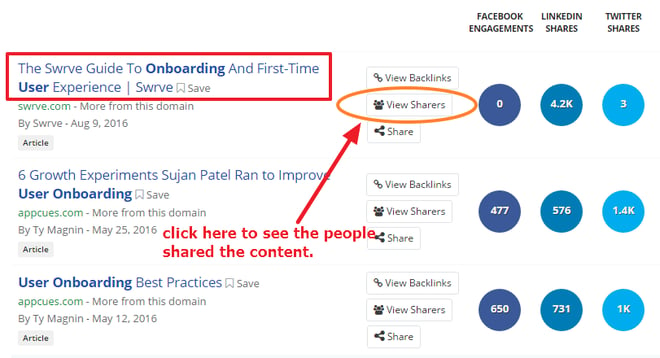
Once you click on “View Sharers” you’ll see the headshots of those who shared the content on Twitter.
These are the people (the majority of them will be micro-influencers) whom you have to connect with and share your new post, with the hope of getting them to share it and link to it.
Of course, if the content is 10x better than the previous content they shared, it shouldn't prove too difficult.
4) Leverage Trending Hashtags
You have seen the list of trending hashtags in your Twitter account, right?
You should leverage trending hashtags to multiply your link building efforts by joining the conversation.
According to Buddy Media, tweets with hashtags receive 2x more engagement than tweets without hashtags.
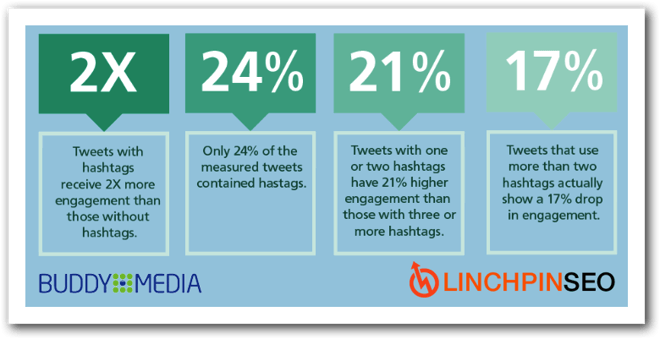
Earning and building more links is a result of the number of people you reach and how much they value your content.
Participating actively in trending hashtags will amplify your reach. You have another opportunity for more people to find you – while they’re busy hashtagging.
Ideally, you could create content around a trending hashtag. To find these hashtags, you can use Twitter or Tagboard.
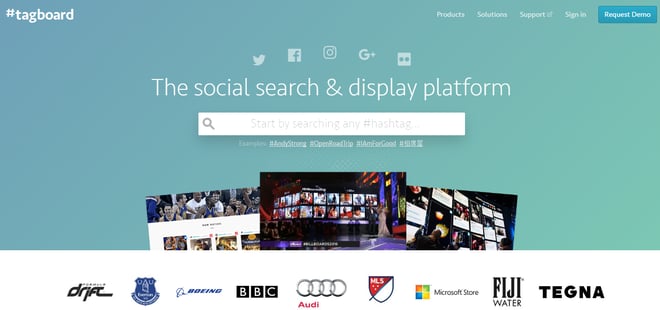
After creating content based on trending hashtags, you can connect with micro-influencers (i.e., influencers that have 1k - 100k fans) and people who have already shared similar content around trending hashtags.
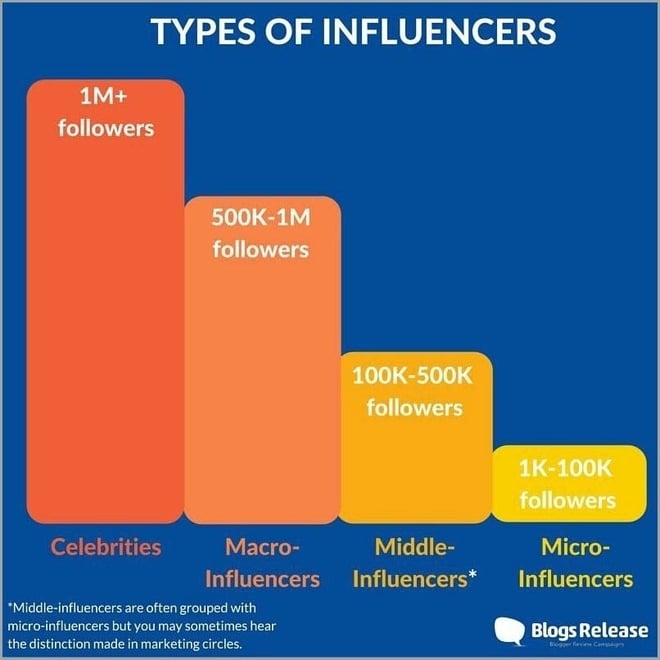
No one is going to share or link to your content if there’s no value in it for them.
For instance, if SEO is a trending hashtag, writing a review of the top SEO companies in your state won't persuade others to share and engage with your content. Rather, create a data-driven article on the psychology behind SEO pricing and why brands should invest in it.
Create content that focuses on audience value. The truth is, if you can get people to think, then they will read, share, promote, and link back to your webpage.
5) Join the Conversation
Perhaps the easiest way to multiply your link building efforts through social is to join the conversation.
Here's the approach I recommend:
- Find influencers in your industry that are most active on social networks especially Facebook, Twitter, and Google+.
- Follow them on social media and on their blogs, and subscribe to their newsletters.
- Comment on their latest posts and articles. Your comment MUST be valuable if you want them to take notice and consider checking out your website.
- Comment, like, and share their posts on social networks.
- Build a relationship with the influencer.
- If you're creating great content, share with the influencers whom you’ve established a level of trust with. Ask for their honest feedback during the creation process. If it's damn good they'll share and/or link to it.
6) Use Facebook Groups
Find public groups that are targeted to marketers. Join the most active groups and start connecting with other people. You can use Facebook groups to build your business and online visibility.
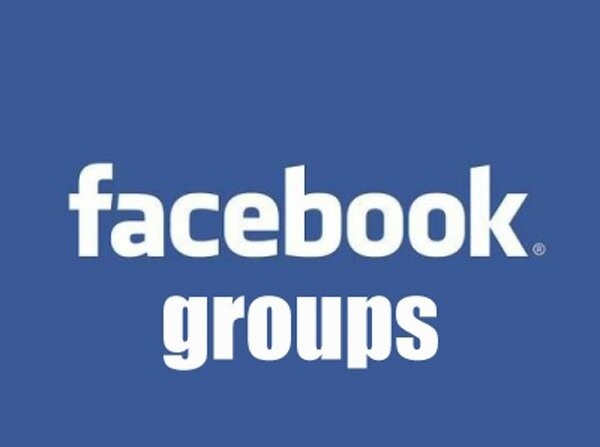
In the words of Maggie Patterson:
“Business happens in real time and using a group with customers or other interested individuals gives you a convenient way to keep members informed about products and services and share information.”
When it makes sense, link to your own content that answers a question or explains a process. You can also use these groups to find ideas to create future content.
Here’s an example of a public group for Oil Painting Artists.
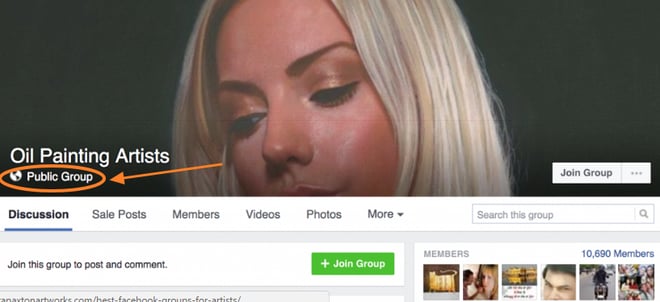
When you answer questions, leave comments, make suggestions, and use your resource post, the group members will certainly check it out.
Side note: Don’t drop your post URL for the sake of it. It must be relevant to the current thread or topic in the group.
The rule is simple: Help group members.
Deliver value by responding to their questions in a friendly manner.
Share a blog post, video, podcast, or any other content that’s relevant to user’s questions. Don't spam groups.
Deliver value to the group members and help them, they will start sharing your posts, and the next time they’re creating content, they’ll consider linking to your resource posts if it’s relevant to the topic of discussion.
Conclusion
Social platforms offer an easy, highly effective way to connect with the right people within your industry – people will be interested in “that” content you poured your heart into.
When you meet and build a relationship with influencers and marketers on a social platform they’re already using, you’re able to build high levels of interaction and engagement that could lead to natural links and improved organic search visibility.
It’s true that social signals may not impact search rankings directly, but they tell Google that your content is valuable to users.
At the end of the day, if people love your content, Google will too. Google's goal is to return results people love.

